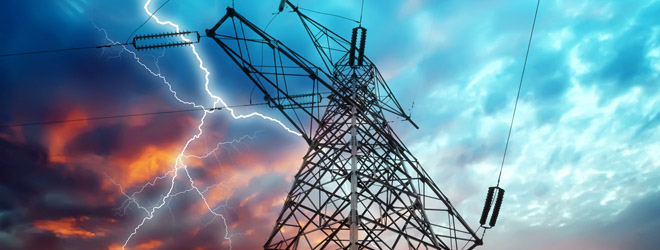In terms of protection against lightning and prevention measures, the 30/30 rule as it is commonly known, is a household measure to protect against lightning strikes. In fact, you wouldn’t have any problem finding information related to the matter with very little research.
Before we start explaining why the 30/30 rule has risks involved and why it is not actually reliable, we would like to clarify first some concepts about what this rule is about and in which ideas this popular belief is based.
What is the rule 30/30 and how it works?
The 30/30 rule is a recommendation to prevent the risk of a lightning strike during a thunderstorm that tells us when it´s time to look for refuge and when the danger is over.
This rule is based on the Flash-to-bang method, which sustains that if the time between we see a lightning bolt and we hear a thunder is less than 30 seconds that means the thunderstorm it´s closer than 10 km (6 miles) and the danger is coming.
According to this rule, it is recommended to stay protected inside of a building or a vehicle during the following 30 minutes after last thunder is heard. ¿Does this mean that in the 31st minute after the last lightning strike we are out of danger? If instead of counting 30 seconds we count 31, ¿does this mean there is no more danger? ¿And what if I don´t hear or see the last strike?
Nowadays, it is well known that this calculation is way too imprecise and, according to statistics, most of the people wounded by a lightning strike were impacted before or after the thunderstorm, but never during one. The fact that people wrongly think they are out of danger simply increases the risk of an accident.
Even though it is widely known that this system is not reliable, it is still recommended, mainly through lack of knowledge. Only reliable lightning detection systems are able to alert effectively about the risk of a lightning strike.
It is important to differentiate between reliable systems, based on advanced technology and with a scientific basis, and methods which are part of popular knowledge. The people in charge of making decisions relating to security in public spheres, in large agglomeration events or outdoor work places, should base their decisions on reliable data and use effective systems.
Why the 30/30 rule is not good advice that should be used to protect ourselves from a lightning impact?
To understand why the 30/30 rule should not be followed, it is necessary to briefly explain what shortcomings and problems this preventive method presents:
- At the time of calculating the risk of a lightning impact, it is not advisable to only consider the distance at which the storm is currently at. Lightning bolts can move more than 10 km (6 miles) inside a thunderstorm.
In fact, there are some studies like Some Aspects of Global Lightning Impacts from the researcher Ronald L.Holle, which shows that more than 80% of injuries and deaths caused by lightning, occurred outside the storm area. For this reason, it is not recommended to only consider the location of a lightning bolt. It is necessary to evaluate both fields, electrostatic and electromagnetic, so that the lightning detector is capable of identifying the risk of a lightning strike either far away or close by.
- The 30/30 rule as a preventive method is far too imprecise in order for people in charge of safety in schools, stadiums, airports or industries to make reliable decisions without taking risks.
Keeping track of the number of lightning bolts and thunder could become complicated in some conditions and situations. For example, counting the seconds between a lightning bolt and thunder requires that there be no interfering noises (which in an industrial setting could become quite complicated) and, moreover this would mean we have to keep our eye on the sky, impending us from carrying out other activities.
- The 30/30 system allows to detect thunderstorms located at the maximum distance of 6 miles. Experts agree we should be using warning systems that detect thunderstorms at a minimum of ten miles, a distance at which the human ear cannot hear thunder.
- In some cases, the warning time offered by the 30/30 formula is not enough. For example, in an industrial setting, implementing a security protocol could require more time, or in the case that we need to seek refuge which could be far away from where we are.
- The preventive measure of maintaining a high-risk level during the following 30 minutes after hearing the last thunder might not be enough in some cases and consequently dangerous. But, in other cases this caution time could be excessive. In industries or big televised sporting events, stopping the activity during an excessive amount of time could involve great economical loss.
The greatest advantage of a technologically advanced lightning detector is that, through the measurement of the electrostatic and electromagnetic field, the data obtained is accurate and specific and once the risk is gone all the alerts can be withdrawn instantly.
- The 30/30 procedure is never going to work if the first strike of a thunderstorm occurs in the place we want to protect. In this case, we will obviously neither see nor hear lightning and therefore we will not have taken any preventive measures.
- The 30/30 technique is not accepted in any of the national or international lightning protection standards, neither is it accepted in the specific lightning warning standard IEC 62793.
How does a reliable lightning detection system work?
In order for the data collected by a lightning detection system to be reliable, it has to integrate an electromagnetic and electrostatic field sensor. The electrostatic field sensor evaluates the conditions of the detection area to alert when the field increases, which happens prior to the first strike in the target area.
Furthermore, the combined action of the two sensors allows to reduce any downtime, which results in a substantial and important cost saving in many industries.
ATSTORM, the early local lightning warning system
The ATSTORM lightning detector, is the expert local system to prevent risks associated with lightning strikes
This system developed by Aplicaciones Tecnológicas, enables detection in all stages of the storm. This device monitors both electromagnetic and electrostatic fields, providing greater anticipation in the localized risk of a lightning strike.
The electrostatic field sensor enables the detection of thunderstorms developing above the target area through the elevation of the electrostatic field.
On another hand, the electromagnetic field sensor enables the detection of lightning bolts in active thunderstorms approaching the target area at a radius of up to 40 km.
In the case of ATSTORM, the risk alerts are received through multiple channels: phones, tablets, web portals, emails and even through the remote operation of warning devices. This makes the control of risks as well as decision making easier for the people in charge of safety.
If you would like to have more information about the ATSTORM lightning detection system, you can request an appointment with one of our experts.


